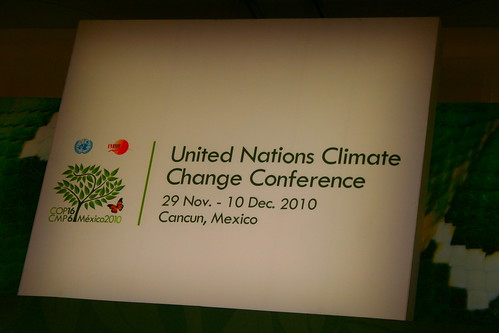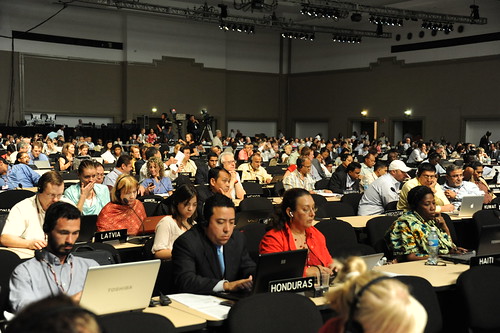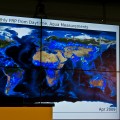Um, What’s Happening in Cancun? Part 1
Tim Hall | December 4, 2010.
Confused with what’s happening at Cancun? Well so am I, and being in Cancun only seems to make it worse. So let’s try and work out what’s going on in Mexico at the moment: COP 101 presented by The Verb. But first, a word from the UKYCC:
So, that’s COP16 in an acronym smothered nutshell. What does it all mean?
Let’s first go right back to the beginning of UN efforts on climate change. In 1988 the Intergovernmental Panel on Climate Change (IPCC) was formed to review and assess recent information, studies and data from around the globe relevant to climate change.
In 1990 the IPCC’s first Assessment Report was published. It made clear that emissions resulting from human activity are substantially increasing greenhouse gas (GHG) concentrations in the atmosphere, causing climate change.
Just to make that clear: twenty years ago (the year both Verb reporters in Cancun were born) the top scientists from around the world were urging governments to act on certain climate change.
In response to this alarming conclusion, in 1992 the UN held the Rio de Janeiro Earth Summit. The Rio summit was at the time the largest assembly of people to discuss the state of the global environment, and many attribute the elevation of environmentalism as an important global issue that needed to be regulated in some capacity to Rio. It produced two notable documents, the Rio Deceleration on Environment and Development and Agenda 21, along with two legally binding treaties: the Convention on Biological Diversity and the United Nations Framework Convention on Climate Change (UNFCCC).
The 154 nation who signed the UNFCCC became tied governments to a voluntary “non-binding aim” to reduce emissions of greenhouse gases with the goal of “preventing dangerous anthropogenic interference with Earth’s climate system”.
It is framework for action, and thus doesn’t force countries to act, but rather proceed in negotiations to figure out how to act. It came into force in 1994, and the following year the first Conference of the Parties (COP) who were part of the Convention, was held in Berlin. The COP is an annual meeting held by the parties to assess progress in dealing with and to negotiate international actions on climate change. Whilst the UNFCCC and the COP are controversial processes, they are widely recognised as the global process for dealing with climate change.
Now, I’ll just pause for a moment and look a bit closer at what the UNFCCC is made up of – important to understanding how negotiations have gone over the last decade and the source of any conflicts. The Convention divided parties into two groups: Annex I countries and non-Annex I countries.
Annex I basically means industrialized countries, commonly known as ‘developed’ nations. In this group are nations such as the United States, Western European nations (now the European Union – EU – as a whole) and umbrella groups (who I’ll go into more detail on later).This group also included economies in transition, in other words Post-Soviet countries who were adopting capitalism after the Soviet Union collapsed.
Non-Annex I countries are ‘developing’ nations, including the Group of 77 (G77; a loose coalition of developing nations which has since expanded to 131 countries), the Least Developed Countries (LDC), the Organization of the Petroleum Exporting Nations (OPEC) and the Alliance of Small Island States (AOSIS), to name a few.
Almost immediately nations got to work filling in the framework, and by the end of COP3 in Kyoto an international treaty on emissions had been designed and signed: the Kyoto Protocol (KP). Annex I countries would be legally bound to reduce emissions on individual targets of an average of 6 to 8 percent below their 1990 emission levels between 2008-2012 – if they ratified the treaty. In accordance with a key climate justice principle adopted in KP, the ‘common but differentiated responsibilities’ principle, the burden to reduce emissions was on developed countries. For the Protocol to come into force it required 55 Parties to have ratified it, of which 55 percent of ratified parties must be Annex I; the catchy 55/55 ratification rule. Between 1998 and 2004 there was a lot of fuss about reaching this requirement that’s not within the scope of this piece, other than to say that there were some major emitters who didn’t like the Protocol. The 55/55 clause was met when Russia ratified in 2004, allowing the Protocol to come into effect in 2005 – albeit without the hostile emitters, most notably the United States. Today 187 parties have ratified the treaty.
If you’re into science, the protocol covered reduction in six GHG’s: CO2, Methane, N2O, HFCs, PFCs, SF6. All I know is they’re all very long names for bad gasses, and that CO2 is what humans emit quite a lot of. Often the other gasses are measured using CO2 as a reference, called CO2 equivalents (CO2-e).
Kyoto also contained within it flexibility mechanisms, which can be used by Annex I nations to meet their reductions. These are the Emissions Trading Schemes (ETS; sometimes called International Emissions Trading – IET), the Clean Development Mechanism (CDM) and the Joint Implementation (JI). ETS is simply emissions trading, regulating carbon by placing a cap on total emissions and allocation permission to emit through permits, the most renowned being the kind implemented in the EU. The CDM and JI on the other hand, are project based reductions – they are produced reductions as they revolve around projects designed to produce lesser emissions than they otherwise could. CDM is based around these projects in developing countries, while JI concerns such projects in Annex I countries.
Just as a side note – mainly to cover acronyms – Kyoto also accounts for ‘Sinks’, that is areas which can impact the global carbon cycle and contribute, or ease, climate change. In particular Land Use, Land-Use Change and Forestry (LULUCF) is a ‘sink’ which is currently having its rules designed.
With Kyoto now in place, a new annual meeting was decided upon within the UNFCCC to coincide with COP, but only involve countries who had ratified the Protocol. In another burst of creativity by the UN, it was titled Meeting of the Parties (MOP or CMP), and was first held in Montreal in 2005. This does not mean non-ratified parties are excluded, but only included as observers.
Observers are any non-parties, such as Non-Governmental Organizations (NGOs) or business coalitions. The Verb is an observer organisation, as is the Australian Youth Climate Coalition or Greenpeace.
OK, so that’s a lot to take in. I still need help when reading through UNFCCC negotiation summaries. But it’s not all there is. In the next post I’ll continue looking at the UN’s efforts on climate change, focusing on the road from Kyoto’s implementation in 2005 to the start of the Cancun COP16, and in doing so shed some light on the SBI, SBSTA, Bali Road Map, AWG-LCA, AWG-KP, REDD, MRV, the Secretariat, the Copenhagen Accord and all the lovely stuff about finance.
Hopefully so far it’s been clear and you’ve gained something. If not, please let me know or email me any questions. In the final post I’ll also upload a recommended reading list if you develop the UNFCCC geek syndrome, like us writers at The Verb have. But until then keep following The Verb’s special coverage of COP16.













comment